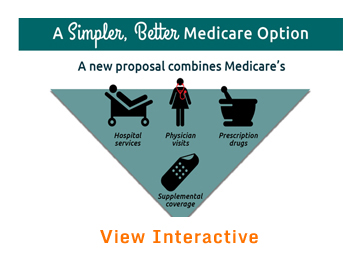Synopsis
Researchers propose a new coverage option for Medicare beneficiaries that would provide comprehensive benefits, protection from catastrophic costs, and incentives for choosing high-quality, high-value care. Combining hospital, physician, and prescription drug coverage, the “Medicare Essential” option could save $180 billion in national health spending in the next decade while also improving care.
The Issue
Research has shown that Medicare beneficiaries are more satisfied with their coverage than are working-age people with employer coverage. Medicare, however, fails to protect beneficiaries against high out-of-pocket costs, unless they purchase two private supplemental policies—a Medigap plan to cover items like copayments and deductibles, and a Medicare Part D plan for prescription drug costs. Karen Davis, of Johns Hopkins Bloomberg School of Public Health, and Commonwealth Fund researchers Cathy Schoen and Stuart Guterman propose a new “Medicare Essential” option that eliminates this complexity by rolling hospital, physician, prescription drug, and supplemental coverage into one health plan. The plan would offer better financial protection than traditional Medicare does, including a limit on out-of-pocket spending. Beneficiaries could see additional cost savings by selecting medical providers that deliver high-value care.
Key Findings
- Medicare Essential’s comprehensive benefits would substantially reduce deductibles and out-of-pocket costs. A single $250 deductible would replace deductibles of $1,156 for each hospital episode and $140 annually for Part B services that were in effect in 2012. Prescription medications would be covered with no deductible, as would preventive care. The plan would set an out-of-pocket maximum of $3,400 a year to protect against catastrophic costs.
- Physicians and hospitals that agree to be reimbursed through innovative payment methods designed to incentivize the delivery of high-quality, efficient care would be designated as “high-value providers.” Beneficiaries who select such providers would save money through reduced cost-sharing.
- Under Medicare Essential, a beneficiary would spend an average of $354 monthly on premiums and out-of-pocket costs, including prescription drugs. This represents a savings of 17 percent compared with a person who currently has traditional Medicare plus Part D and Medigap Part F supplemental plans. Medicare Essential enrollees who use high-value providers would save even more: they would spend an estimated $254 a month, for a savings of 40 percent.
- Overall, the Medicare Essential option would reduce total health spending by $180 billion between 2014 and 2023, by simplifying administrative costs, encouraging value-based health care decisions, and shifting beneficiaries into patient-centered medical homes and accountable care organizations that meet high standards for care coordination and management of high-risk, high-cost conditions.
- Under the plan, households would save $63 billion, private employers would save $90 billion in retiree plans, and state and local governments would save an estimated $27 billion over 10 years.
Addressing the Problem
Medicare Essential would not add to the federal budget deficit, because its enhanced benefits are financed by premiums, which would be substantially lower than current payments for Medigap and Part D drug plans. The savings come partly from lower administrative costs compared with supplemental coverage purchased in the private insurance market, where administrative costs range from 10 percent to 20 percent, versus 2 percent for traditional Medicare.
About the Study
To draft the proposed benefit design, the authors used modeling by Actuarial Research Corporation (ARC) to estimate the potential 10-year impact on premiums and out-of-pocket costs. ARC compared projected costs to estimated costs for people enrolled in both traditional Medicare and supplemental private coverage, assuming the new Medicare Essential option would be available starting in 2014.
The Bottom Line
Combining Medicare hospital, physician, prescription drug, and supplemental coverage into a single health plan could save $180 billion in overall health spending over the next decade while reducing out-of-pocket costs for beneficiaries and improving care.
